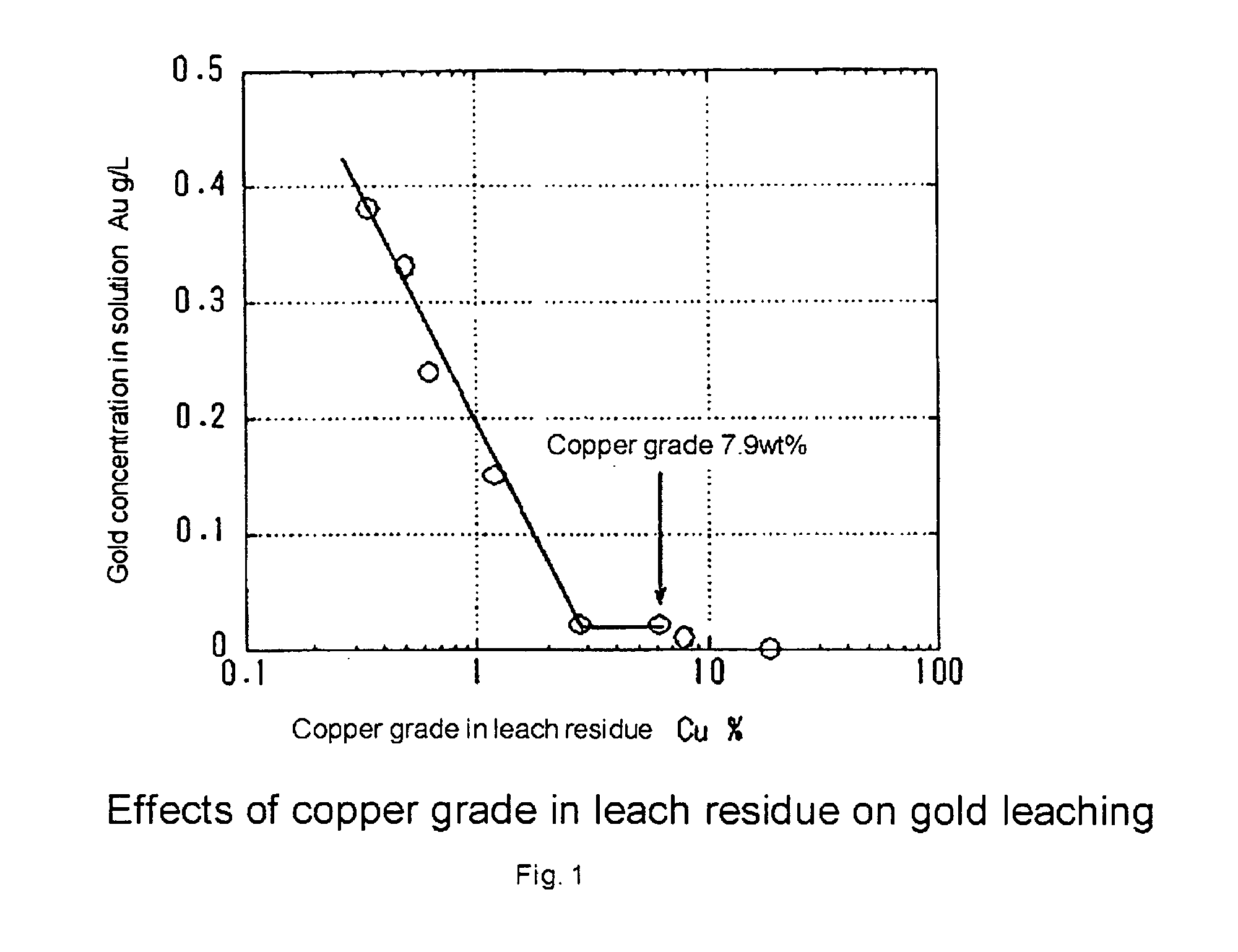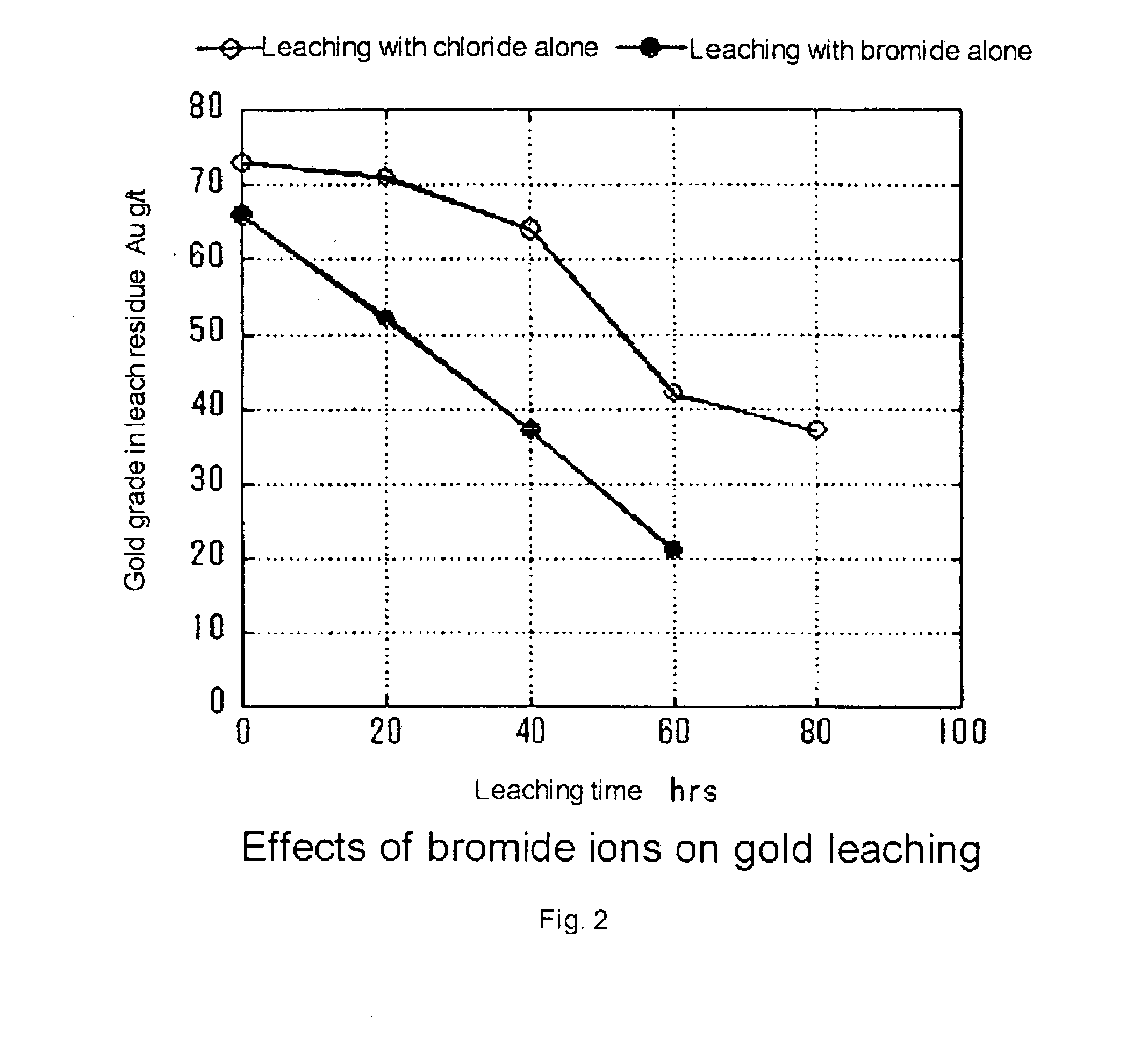Process of leaching gold
a technology of leaching gold and gold, applied in the field of leaching gold, can solve the problems of troublesome handling, inconvenient large-scale leaching, and excess amount of oxidizing agents, and achieve the effect of improving efficiency
- Summary
- Abstract
- Description
- Claims
- Application Information
AI Technical Summary
Benefits of technology
Problems solved by technology
Method used
Image
Examples
example 1
Reference Example
[0087]A leaching solution containing cupric chloride in a copper concentration of 25 g / l, ferric chloride in an iron concentration of 2 g / l, chloride ions including those from the cupric chloride and ferric chloride in a chloride ion concentration of 180 g / l in total, and sodium bromide in a bromide ion concentration of 22 g / l was prepared. To 9 L of the leaching solution, 1,260 g of a copper concentrate having a composition of 31.7 wt % Cu, 17.5 wt % Fe, 22.1 wt % S, and 66 g / t of Au as a material was added.
[0088]The copper concentrate was composed of 15% chalcopyrite (CuFeS2) and 35% chalcocite (Cu2S) as copper sources, in addition to 18% silicate ore, and 32% pyrite (FeS2). Out of gold, 15% is present in the pyrite, and 85% is present throughout the other ores.
[0089]The leaching solution was heated to 85° C. and then the concentrate material was added with stirring. Analyte was sampled from the mixture with stirring and air bubbling to determine the gold concentr...
example 2
Reference Example
[0092]A leaching solution containing cupric chloride in a copper concentration of 31 g / l, chloride ions including those from the cupric chloride in a chloride ion concentration of 186 g / l in total, and sodium bromide in a bromide ion concentration of 26 g / l was prepared. To 10 L of the leaching solution, 712 g of a copper concentrate having a composition of 15 wt % Cu, 19 wt % Fe, 17 wt % S, and 82 g / t of Au as a material was added.
[0093]The leaching solution was heated to 85° C. and then the concentrate material was added with stirring. The leaching was carried out with air bubbling. Hydrochloric acid was added to adjust the pH within the range of 0.5 to 2. Table 2 shows the results of this example.
TABLE 2Results of measurement in Example 2Grade inConcentrationReactionleach residuein solutiontimeTemperatureORPCuAuhrs.° C.mVpHwt %Au g / tFe g / Lmg / L0785951.315.0820 00.1854511.77.694—0.020.7854751.52.1760.280.021.7855141.51.263—0.152.7855571.71.0430.040.32ORP is measur...
example 3
Inventive Example
[0095]To 4 L of a leaching solution containing no bromide ion, 524 g of a copper sulfide ore (22.1 wt % Cu, 23.4 wt % Fe, 29.1 wt % S, and 73 g / t of Au) was added, and the mixture was heated to 85° C. to carry out leaching with air bubbling. The composition of the leaching solution was as follows: cupric chloride in a copper concentration of 5.1 g / l, ferric chloride in an iron concentration of 5.1 g / l, and the total chloride concentration of 126 g / l by addition of sodium chloride. The reaction mixture was filtered every 20 hours, and each of the resulting leach residues was mixed with a fresh leaching solution having the same composition, and was subject to further leaching. Table 3 shows the result of this measurement.
TABLE 3Results of measurement in Example 3Grade inConcentrationReactionleach residuein solutiontimeTemperatureORPCuAuhrs.° C.mVpHwt %Au g / tFe g / Lmg / L0557521.422.1735.1020845531.00.16711.21.540865411.10.08646.51.560845411.10.04425.60.680835441.1—375.80...
PUM
| Property | Measurement | Unit |
|---|---|---|
| concentration | aaaaa | aaaaa |
| concentration | aaaaa | aaaaa |
| temperature | aaaaa | aaaaa |
Abstract
Description
Claims
Application Information
 Login to View More
Login to View More - R&D
- Intellectual Property
- Life Sciences
- Materials
- Tech Scout
- Unparalleled Data Quality
- Higher Quality Content
- 60% Fewer Hallucinations
Browse by: Latest US Patents, China's latest patents, Technical Efficacy Thesaurus, Application Domain, Technology Topic, Popular Technical Reports.
© 2025 PatSnap. All rights reserved.Legal|Privacy policy|Modern Slavery Act Transparency Statement|Sitemap|About US| Contact US: help@patsnap.com



